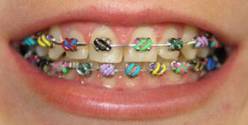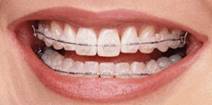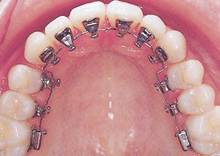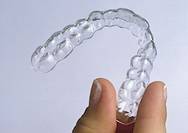
| Orthodontics 1. What is orthodontics? 2. How many types of ortho? 3. What makes teeth not straight 4. Teeth pulled or not? 5. Wisdom teeth? 6. Teeth removal for braces 7. Necessary for braces? 8. Best ortho tx 9. Pros and cons of ortho 10.How much time 11.Ortho expense 12.No time to come for tx 13.Can everyone have braces? 14.Does age matter? 15.What age? 16.Prepare for braces 17.Painful? 18.Post-op care 19.Adult - too late? 20.Can teeth straighten on their own? 21.Food cannot eat 22.Go to school 23.How Do Teeth Move? 24.How long to complete tx? 25.How often brushing? 26.How often the appt? 27.Hurt? 28.Is it ever too late for a person to get braces? 29.Ortho in baby teeth 30.Phase one 31.Recycled braces 32.See dentist when in braces 33.Shots? 34.Sports 35.Wear braces with crowns and missing teeth 36.What Causes Crooked Teeth? 37.What is the Best Time for Orthodontic Treatment? 38. Why is it important to have orthodontic treatment at a young age? 39.Will It Hurt? |
|
| Orthodontics | |
| Q : | What is Orthodontics? |
| A : | Orthodontics is the way to help aligning crooked teeth or spacing arches to a better and more beautiful alignment. This will ease the cleaning of the teeth and also enable the face to look much better. |
| Q : | |
| A : | Generally, there are two main types of Orthodontics : Fixed type, and Removable type. However, it can be divided into 1. Labial Orthodontics which can be divided into 1.1 Metal Braces The appliances are made of metal and are visible.
1.2 Ceramic or Resin Braces (or so-called tooth-colored braces) provided more esthetic as they are tooth-colored.
1.3 Damon System (or Damon Braces) This system is a self-ligating system without the use of elastic ring to hold the wires. Damon-2 is all-metal with slightly different mechanism from Damon-3, which is half-metal, half-ceramic and the latest innovation is Damon MX which has the same mechanism as Damon-3 but is made of all metal.
2. Lingual Orthodonitcs No braces showing when smiling results in more esthetic looks.
3. Clear Aligners :- Invisalign ®, Essix ®. Straight teeth. No braces. Wireless. Appliances are made of clear resin which are worn onto the teeth in both arches. They are really "invisible" and look very natural. Easy to take care of natural teeth because they can be taken out when eating and brushing which results in convenience in cleaning teeth and also when eating food.
Sometimes, the problem is not about teeth alone, but is also from bony structure of the jaw as well. Therefore, to do merely Orthodontic treatment might not be enough. The jaw surgery might be helpful as an auxiliary treatment in the case that needs bony adjustment. The above types of orthodontics have their own indications and contra-indications, depending on each individual's problem. Therefore, consultation with orthodontists is important and necessary in order to find the best solution for each individual. |
| Q : | What makes teeth not straight? |
| A : | Naturally, human teeth will erupt from natural force of tooth buds. If there is any obstacle for eruption, the tooth cannot erupt in a proper position. Therefore, the tooth will try to find other direction to erupt so that it can come up. Generally, the permanent teeth will replace the primary (baby) teeth. The root of the primary teeth will resorb due to the eruption force of the erupting permanent teeth. The primary teeth will then be mobile and eventually coming out of the mouth. If the primary teeth is not out while the permanent teeth is erupting, then the teeth will stay crowdedly and cause the crooked teeth in the future. In those who have early loss of primary teeth, maybe from deep decayed of the tooth that eventually needs to be pulled out, the replacing permanent teeth underneath will have no direction as a guide to erupt. This may lead to rotated teeth or malposition. The adjacent permanent teeth may come up into the space of early loss teeth resulting in reduced space which may not be enough for the permanent tooth to erupt completely. The permanent tooth may then erupt tilted, crowded. “Space Maintainer” should be worn in order to prevent the adjacent erupting teeth to come up into the space while waiting for the replacing permanent teeth to erupt, then the space maintainer can be removed. In some persons, the size of the jaw is smaller than the total size of all teeth that are going to erupt into the jaw causing crowded teeth. Vice versa, if the total size of all teeth is less than the size of the jaw, there will be space in between teeth. For those who have teeth extracted and have not had any substitute teeth, the teeth will migrate to the extraction space as time goes by causing generalize spacing as well. Sometimes, oral mucous membrane itself may interfere the eruption of the teeth. For example, the ligament (frenum) that attach to the lips or to the tongue. The position of the attachment can prevent the teeth from coming close to each other leading to spacing in between the teeth. To correct such problem, the ligament has to be trimmed using either laser or blade in order to change the position of the attachment. Some habits can cause malaligned teeth; such as, mouth breathing, fingers or lip sucking, abnormal swallowing by using the tongue to push the teeth during swallowing. Fingers or lip sucking can cause the teeth to protrude forward and the lower lip being pushed in, the palate gets narrower. Abnormal swallowing can keep upper and lower teeth apart due to the tongue in between and the tongue pushes the teeth to move forward causing spacing and protruded teeth. |
| Q : | Is it necessary to have teeth pulled in every orthodontic case? |
| A : | Generally, orthodontics needs to have movements of teeth. In case of very little space for such movements, for example, crowded teeth, then it is necessary to gain space for teeth to be able to move. This can be done by either having some of the teeth pulled out or reducing the size of some teeth. If there is enough space, for example, some teeth had been pulled out, have missing teeth, or generally spacing, then it may not be necessary to pull out more teeth. |
| Q : | What about wisdom teeth? Do they need to be removed before braces? Or can be done afterward? |
| A : | “Wisdom teeth” have never been wanted by any dentists; therefore, even if not having orthodontic treatment, they are strongly recommended to be removed. This is to help make the cleaning inside the oral cavity easier and more thoroughly. However, the necessity of wisdom teeth removal depends on many factors; for example, age, teeth and gum condition, etc., which the dentist will evaluate individually. Oral care in those who have orthodontic appliances in the mouth is more complicate than in those who do not have. If there is any wisdom teeth that are hard to take care of, the teeth are usually advised to be taken out. This is not just for orthodontic purpose, but also for a better oral hygiene. If found that the wisdom teeth may come up in a direction which can push other teeth out of the alignment, then to remove the wisdom teeth prior to or during orthodontic treatment is recommended. If not, then after orthodontic treatment is done, the well-aligned teeth may move to undesired position causing problems of rotated or crooked once again and the patient needs to come back to redo the braces all over again to straighten the teeth. This time, the orthodontic process maybe more complicated than the first time. Wearing retainers is still necessary as retainers can help keeping the teeth into their aligned position although the wisdom teeth have not yet been removed. The problem of crowding is likely not easy to occur. Nevertheless, to remove the wisdom teeth is still recommended – especially, when the wisdom teeth have erupting direction that can push other teeth to move out of alignment. |
| Q : | |
| A : | Removing teeth is sometimes needed to get the best orthodontic result. Straight teeth and a balanced facial profile are always the goal. However, because today's technology has resulted in advanced orthodontic procedures, the need for removing teeth has been greatly reduced. |
| Q : | |
| A : | When proper alignment of teeth can create a better bite, a better relationship of upper and lower jaws, and can ease a better cleaning and oral care, then the orthodontic treatment is recommended. However, this depends on the ability of each person how they can manage the timing and expenses. If he or she does not have enough time or cannot afford the treatment, then this limitation will require other treatment options. |
| Q : | |
| A : | Each technique has its own indications, contra-indications, and limitations, which includes pricing and timing used in the treatment. Therefore, there might be more than one method that fit each individual. Many factors have to be put into consideration before eventually selecting any specific treatment. Each individual has his own problem, so the treatment chosen has to depend on the problems and other factors of each individual. |
| Q : | |
| A : | Orthodontics is to make teeth into good alignment by not changing original teeth shape and form. Therefore, the pros are that the teeth are still our own natural teeth without the need to add in or grind out. The process of natural gum massaging by the food passing through the shape of the teeth will still be the same as usual. This results in healthy gum and other tissues around the teeth. The cons are that the time used in orthodontic treatment is long and incur quite high expenses. Also, the difficulties in teeth cleaning and keeping good oral hygiene while wearing orthodontic appliances will be a problem. Besides, long term retainers wearing after removal of orthodontic appliances is necessary in order to maintain the teeth into the desired position. Otherwise, the teeth may move back to the original position prior to orthodontic treatment. |
| Q : | |
| A : | Mostly, orthodontic treatment needs about 2 years – more or less. This depends on the difficulties of each problem. Then after the removal of the orthodontic appliances, the retainers are needed to be worn as long as possible so that the teeth will stay in good shape and correct position. |
| Q : | |
| A : | An orthodontic case can cost about 10,000 baht up to 250,000 baht depending on the types of problem, the types of orthodontic technique, and appliances chosen. It also depends on each clinic. The terms of payment and promotional campaigns varies depending on each clinic as well. |
| Q : | |
| A : | Once decided to start orthodontic treatment, one will have to sacrifice some time to come for the treatment according to the appointments made with the orthodontist for best treatment result and most beneficial to the patient. Usually, the appointment is made every 3-4 weeks for about 2 years. If known not being able to come for continual treatment this frequent since the first day of the decision of having orthodontic treatment, then the patient should consider having the treatment done at the place where he or she is more convenient in going or may consider other techniques that do not need to come for the treatment that often. If after having started orthodontic treatment for some time, then later found out that the patient cannot continue the treatment, then the case can be referred to other orthodontist who works in the area where the patient can go so that the case can be completed. |
| Q : | |
| A : | If the problem comes merely from teeth, the braces can certainly help, but the necessity of having braces depends on orthodontist’s consideration and the co-operation and consent of the patients. The problem that comes from not only teeth, but also from jaw bone, then the orthodontic treatment may not be enough as it cannot correct bony problem. The combination between orthodontic and surgery should be considered. The problem may not be solved completely if the patient does not want to have jaw surgery. Then it might be a better idea to leave it as it is until the patients agree on jaw surgery. |
| Q : | |
| A : | “Age” really does not matter in orthodontic treatment. However, the jaw bone gets stronger as you get older, so the tooth movement will be more difficult. Therefore, the time used in orthodontic treatment will be longer. If considered necessary, orthodontic treatment can still be done without any problem no matter how old the patients. |
| Q : | At what age should I schedule an appointment for an orthodontic screening & evaluation? |
| A : | The American Association of Orthodontists recommends an orthodontic screening at age seven. By this age, the six-year molars and several permanent teeth in most children have erupted that allowing the doctors to effectively evaluate most developing orthodontic problems early. Also, jaws are developed enough so that the dentist and orthodontist can see if there will be any serious bite problems in the future. Most of the treatment time is not necessary at age 7, but it gives the parents and dentist time to watch the development of the patient and decide on the best mode of treatment. When you have time on your side you can plan ahead and prevent the formation of serious problems. |
| Q : | |
| A : | When you need to have braces, you should see an orthodontist in order to consult for the necessity and possibility of the treatment. If braces can be done, then oral care - such as, fillings, cleaning, root canal treatment, or sometimes extraction, should be done prior to putting the braces on. If oral condition is healthy, you will be ready for the braces. The orthodontist will order more extractions when needed, then it’s time to go for the real braces!! |
| Q : | |
| A : | Orthodontics is to move teeth from the original position into the desired position; therefore, it is possible and likely to feel pain. However, the pain will not be long. Usually, the pain will stay for about 3-4 days after applying orthodontic force onto the teeth. Afterward, there will usually be no pain until the next force applying which is usually the next orthodontic appointment. There might be soft tissue injuries due to the poking wires or sharp appliances that are on the teeth. This can be solved by wire cutting by a dentist or use soft orthodontic wax to cover all sharp areas to help reduce the irritation; thus, reduces the pain. |
| Q : | |
| A : | During orthodontic treatment, the patient should clean well and thoroughly and take good care of the oral hygiene. The use of dental floss is highly recommended. Auxiliary cleaning appliances should be used for more thoroughly cleaning. After braces removal, the aligned teeth will have nothing holding them so they can still move back and forth. Therefore, the retainers should be worn in order to prevent the problem of crooked teeth. The well-aligned teeth and the retainers should also be cleaned and taken care of well. |
| Q : | Is it too late to have braces if I am already an adult? |
| A : | A surprising percentage of our patients are adults. Health, happiness and self-esteem are vitally important to adults. No patient is "too old" to wear braces! |
| Q : | Will my child's teeth straighten out on their own as they grow? |
| A : | No,most probably No, they will not. The space available for the front teeth does not increase as a child grows. In most people, after the permanent 6-year molars erupt, the space available for the front teeth actually decreases with age. |
| Q : | |
| A : | Yes. Once treatment begins, very complete instructions and a comprehensive list will be provided regarding foods to avoid. Some of those foods include: ice, hard candy, raw vegetables and all sticky foods (i.e. caramel and taffy). Many emergency appointments to repair broken or damaged braces can be avoided by carefully following instructions regarding what foods to avoid. |
| Q : | |
| A : | Yes. There is no reason to miss school because of an orthodontic appointment. |
| Q : | Can orthodontic correction occur while a child still has some baby teeth? |
| A : | Yes. Some orthodontic problems are significant enough to require early intervention. However, if a patient is not yet ready for treatment, we will follow that patient's growth and development until the time is right for treatment to begin. |
| Q : | |
| A : | Phase One treatment, when needed, is usually initiated on children between the ages of seven and 10. Phase One treatment usually takes about 12-21 months. There are several primary objectives for Phase One treatment.
|
| Q : | |
| A : | Absolutely not! It is our belief that each patient should be provided with their own braces to achieve the very best orthodontic result possible. |
| Q : | |
| A : | Yes! Regular checkups with your family dentist are very important while in braces. Your family dentist will determine how often you should be seen for cleaning appointments while you are in braces. |
| Q : | |
| A : | No. No shots are necessary in orthodontic treatment. |
| Q : | |
| A : | Yes. We can recommend a mouth guard for all sports. Custom made mouthguards are available upon request.
|
| Q : | Can I wear braces even though I have crowns and missing teeth? |
| A : | Yes. A tooth with a crown will move just like a tooth with a simple filling. When teeth are missing, orthodontic treatment will aid in the alignment of the remaining teeth so that the space where the teeth are missing can be properly restored. |
| Q : | |
| A : | Crowded teeth, thumb sucking, tongue thrusting, premature loss of baby teeth, a poor breathing airway caused by enlarged adenoids or tonsils can all contribute to poor tooth positioning. And then there are the hereditary factors. Extra teeth, large teeth, missing teeth, wide spacing, small jaws - all can be causes of crowded teeth. |
| Q : | What is the Best Time for my child to seek for Orthodontic Treatment? |
| A : | The AAO recommends that every child should see an orthodontist no later than age 7. However, developing malocclusions, or bad bites, can be recognized as early as 2-3 years of age. Many orthodontic problems are easier to correct if detected early rather than waiting until jaw growth has slowed. Early treatment may mean a patient will avoid surgery or other more serious corrections later in life. Often, early steps can be taken to reduce the need for major orthodontic treatment at a later age. Stage I – Early Treatment: This period of treatment encompasses ages 2 to 6 years. At this young age, we are concerned with underdeveloped dental arches, the premature loss of primary teeth, and harmful habits such as finger or thumb sucking. Treatment initiated in this stage of development is often very successful and many times, though not always, can eliminate the need for future orthodontic/orthopedic treatment. Stage II – Mixed Dentition: This period covers the ages of 6 to 12 years, with the eruption of the permanent incisor (front) teeth and 6 year molars. Treatment concerns deal with jaw malrelationships and dental realignment problems. This is an excellent stage to start treatment, when indicated, as your child’s hard and soft tissues are usually very responsive to orthodontic or orthopedic forces. Stage III – Adolescent Dentition: This stage deals with the permanent teeth and the development of the final bite relationship. |
| Q : | Why is it important to have orthodontic treatment at a young age? |
| A : | Research has shown that serious orthodontic problems can be more easily corrected when the patient’s skeleton is still growing and flexible. By correcting the skeletal problems at a younger age we can prepare the mouth for the eventual eruption of the permanent teeth. If the permanent teeth have adequate space to erupt they will come in fairly straight. If the teeth erupt fairly straight their tendency to get crooked again after the braces come off is diminished significantly. After the permanent teeth have erupted, usually from age 12-14, complete braces are placed for final alignment and detailing of the bite. Thus the final stage of treatment is quicker and easier on the patient. This phase of treatment usually lasts from 12 - 18 month and is not started until all of the permanent teeth are erupted. Doing orthodontic treatments in two steps provides excellent results often allowing the doctor to avoid removal of permanent teeth and jaw surgery. The treatment done when some of the baby teeth are still present is called Phase-1. The last part of treatment after all the permanent teeth have erupted is called Phase-2. |
| Q : | |
| A : | When teeth are first moved, discomfort may result. This usually lasts about 24 to 72 hours. Patients report a lessening of pain as the treatment progresses. Pain medicines such as acetaminophen (Tylenol) or ibuprofen (Advil) usually help relieve the pain. |
941 Sukhumvit Road (between soi 51-53), Klongton Nua, Wattana, BKK 10110, Thailand. Tel.+66 2 662 5065, Fax.+66 2 662 5064
Map , E-mail: info@dentist51.com or dentist51@gmail.com





